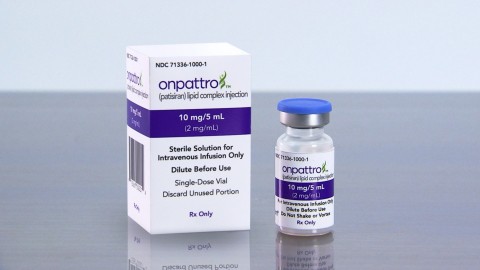
NICE has reversed an earlier decision to reject Alnylam’s Onpattro, helping it compete with rival treatment Tegsedi (inotersen).
Marketed by Ionis subsidiary Akcea Therapeutics, Tegsedi stole a march over Onpattro when it gained NICE approval in April, but now Alnylam has a matching recommendation from England’s cost watchdog.
Both Onpattro and Tegsedi are licensed to treat the ultra-rare disease hereditary transthyretin-mediated amyloidosis (hATTR) in adults with stage 1 or 2 polyneuropathy, or damage to peripheral nerves.
The effects and complications of the condition can lead to death within 3 to 15 years of symptoms developing, and there are thought to be only 150 people with the condition in the UK.
The thumbs up from England’s cost effectiveness watchdog is an important milestone for Alnylam and Onpattro, its first marketed drug and the first-of-its-kind RNAi gene silencing treatment.
Onpattro is expected to have the upper hand on its rival (which targets RNAi with a different mechanism) in global markets, but will have to make up lost ground in England.
Alnylam’s product is an intravenous drug given every three weeks, while Tegsedi is a weekly self-administered injection under the skin. However, while Tegsedi’s administration is more convenient, it also carries a boxed warning on low platelet counts.
Alnylam says its drug can also be administered at home once treatment is established, and is hopeful that continuing clinical studies will show superior outcomes for its therapy.
The UK list price for both drugs is around £300,000 for a year’s treatment, but Alnylam has now followed its rival by offering a discount which swung NICE’s decision.
The two rivals also face competition from Pfizer’s Vyndaqel (tafadamis). It has been available in Europe for a number of years as a polyneuropathy treatment, but recently gained US approval for patients with the cardiomyopathy (CM) subtype of transthyretin-mediated amyloidosis (ATTR), with European approval set to follow shortly.
In its pivotal APOLLO trial, 56% of the study’s 225 patients treated with Onpattro saw an improvement in their neuropathy symptoms, compared with 4% of patients treated with placebo.
However NICE’s initial reservations had been about just how significant the impact of this improvement was for patients, especially in the long term. Alnylam is now looking to prove Onpattro’s long-term value to patients, and recently published data from APOLLO showing its benefits for patients in relation to neuropathy symptoms and quality of life, four years into treatment.
The company also highlighted the fact that around a third of patients enrolled on its APOLLO trial were previously treated with Vyndaqel, with a third of this number having ended treatment because of disease progression.
Alnylam reports that these patients respond well to Onpattro on the trial, with similar results to the overall trial population in terms of polyneuropathy and quality of life.
Onpattro’s market performance hasn’t started with a bang: it earned just $26.3m in the first quarter of this year, but this was well ahead of the $7m achieved by Tegsedi in the same period. Both companies will be hoping for an acceleration in uptake this year in the US and Europe.
Professor Philip Hawkins, head of the National Amyloidosis Centre at the Royal Free Hospital, London, commented on yesterday’s NICE decision, saying it was an important step forward for the patients with the life-threatening disease.
“Patisiran has shown in its main clinical study that it can halt or even improve potentially debilitating symptoms of this disease in the majority of patients.
“This means we now have a real possibility of preserving quality of life for eligible patients for longer than has so far been possible.
“Gene-silencing is a promising area of medicine and it is heartening to see this science translating into treatments that can potentially help those suffering from serious illnesses like hATTR amyloidosis.”




